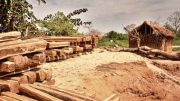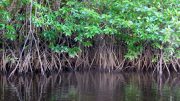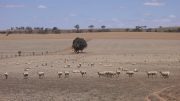- Deforestation is amplifying climate change effects in the Brazilian Cerrado savanna biome, making it much hotter and drier. Researchers observed monthly increases of 2.24°C (4.03°F) in average maximum temperatures between 1961 and 2019. If this trend persists, temperature could be 6°C (10.8°F) higher in 2050 than in 1961.
- Cerrado air moisture is decreasing partly due to the removal of trees, which bring water up from as much as 15 meters (nearly 50 feet) underground to carry on photosynthesis during the dry season. Replacement of native vegetation by crops also reduces the absorption of sunlight by wild plants and leads to an increase in temperature.
- Even dew, the only source of water for smaller plants and many insects during the dry season, is being reduced due to deforestation and deepening drought. The demise of pollinators that rely on dew may prompt a cascading effect adversely impacting the biome’s biodiversity, which could collapse in the next 30 years.
- The Cerrado is often called Brazil’s “water tank,” as it is the source of eight of 12 Brazilian river basins. Its looming biome collapse and deepening drought mean less water for rural and urban populations and for agriculture. Low flows in rivers will also affect hydropower, likely causing energy shortages.
One of the world’s biodiversity hotspots and a vital source of much of Brazil’s water, the Cerrado biome may collapse in less than 30 years if agribusiness keeps advancing at its current frenetic pace. That is the key finding of a primary research article presented by 12 Brazilian scientists and recently published in Global Change Biology.
The tropical savanna, which lies south and east of the Amazon rainforest, is an immense biome covering 2 million square kilometers (772,000 square miles), or an area the size of Mexico, and inclusive of all or parts of 10 Brazilian states.
With a dry season that lasts roughly from June to September, and soils poor in nutrients, the savanna’s native vegetation is composed mainly of grasslands dotted by dry forest patches. While the biome lacks the gigantic rainforest trees of the neighboring Amazon, that doesn’t prevent the Cerrado from being a very rich bastion of biodiversity. It is home to more than 4,800 plant and vertebrate species found nowhere else in the world.

This frog species Physalaemus nattereri (posterior view shown) is found in the open Cerrado, but not in adjacent gallery forests. Image by Felipe Gomes via Wikimedia Commons (CC BY-SA 2.5).
“We are talking about entire lineages of life that will disappear, not to mention several insects that only exist in Cerrado,” warns Gabriel Hofmann, a doctor in ecology and postgraduate student in geography at Rio Grande do Sul Federal University (UFRGS).
The desertification of the Cerrado: Hotter, drier … deadlier
Hofmann is the lead author of the new study that analyzes how the conversion of native vegetation to cropland is accelerating climate change in a biome that has already seen almost half of its area converted into soy, corn and cotton plantations, and cattle pasture. Most of the rapidly escalating deforestation happened after the 1990s, when agribusiness producers focused on a part of the biome they dubbed Matopiba — a portmanteau of the names of four Cerrado states: Maranhão, Tocantins, Piauí and Bahia. Today, this region has become the heart of Brazil’s new agriculture frontier.
Today’s savanna is vastly hotter and drier than it once was, the new paper concludes from analysis of temperature and precipitation changes encompassing six decades. Monthly increases of 2.24° Celsius (4.03° Fahrenheit) in average maximum temperatures were observed between 1961 and 2019, with peaks of 4°C (7.2°F) in the month of October. If this tendency persists, temperature will be 6°C (10.8°F) higher by 2050 as compared to 1961, the paper states.

The paper concludes that today’s savanna is vastly hotter and drier than it once was. Scientists believe the average maximum temperatures in the Cerrado may become 6°C (10.8°F) higher in 2050 than they were in 1961. Image by Christoph Diewald via Flickr (CC BY-NC-ND 2.0).
“Climate change per se would already have this [hotter and drier] effect on the region. What we are doing is amplifying this effect by expanding the areas of crops, like soy, and reducing the native vegetation cover,” explained Francisco Aquino, a UFRGS geography professor who was one of the study authors and spoke with Mongabay by phone.
The scientists explain that human interference is disrupting an efficient nature strategy. During months of little or no rain, the Cerrado’s trees use their deep roots to tap water in aquifers up to 15 meters (nearly 50 feet) underground. This allows plants to keep photosynthesizing and releasing water into the atmosphere via transpiration and evaporation, even in the dry season.
But with the advance of agribusiness, many trees were replaced by crops. “In the dry season the farmers don’t plant anything in Cerrado. They leave the soil bare or [covered] with dead organic material,” explained Hofmann. “As there are no plants to absorb the energy of the sun and to do photosynthesis, all this energy is used to heat the air and the temperature increases.”
This heating-drying process prompts a cascading effect that may knock out much of the Cerrado’s biodiversity. Smaller plants, which don’t have long tap roots, rely on dew as their only source of water in the dry season. Dew usually forms at night when cooler temperatures cause atmospheric moisture to condense (after passing into the air via transpiration and evaporation from deep-rooted trees). But now, with fewer trees and less water vapor in the air, along with higher daytime and nighttime temperatures, dew is an increasingly rare phenomenon. “These plants will simply toast in the sun,” said Hofmann.
Insects, including bees and ants, and spiders are also very dependent on dew as a source of water. “If you take out the pollinator insects, the ecosystem collapses,” concluded Hofmann, who foresees a Cerrado biodiversity collapse within the next 30 years.
“We may see Cerrado turn into something very similar to a desert,” warned Tércio Ambrizzi, a professor with the Department of Atmospheric Sciences at São Paulo University (USP) who was not involved in the study. Ambrizzi, who studies climate change in South America, said the findings of Hofmann’s research team confirm the predictions he and other researchers made eight years ago for the Brazilian Panel on Climate Change.
“These findings show that we are going to have less rain in the north and northeast of Brazil, therefore Cerrado will be hotter and drier and more vulnerable to fires,” he told Mongabay in a video call. In 2019, INPE, the governmental body that monitors deforestation and fires in Brazil, registered 63,874 fires in the Cerrado — a 61.92% increase from the year before. The number of fires remained high in 2020.
Perfect human-induced storm in the Cerrado
In 2017, Bernardo Strassburg from Pontifícia Universidade Católica do Rio de Janeiro (PUC University), warned of what he called a perfect storm in the Brazilian tropical savanna, as the combined impacts of agribusiness expansion, infrastructure development, poor legal land protection, and limited conservation incentives collide.
According to the article he published then, titled “Moment of truth for the Cerrado hotspot,” public protected areas cover a mere 7.5% of the biome (compared with 46% in the Amazon), while under Brazil’s Forest Code just 20% of private lands are required to be set aside for conservation (compared with 80% in the Amazon).
Moreover, the Soy Moratorium, an agreement by which commodities traders don’t buy soy from recently deforested lands in Legal Amazonia, doesn’t apply to the Cerrado. Attempts to get commodities companies to agree to a similar moratorium for the savanna, known as the Cerrado Manifesto, have largely failed.
“The picture we found is somber,” wrote Strassburg. If nothing changes, he estimated, more than 30% of remaining Cerrado native vegetation is likely to be cleared for agriculture by 2050, possibly resulting in the extinction of 480 endemic plant species; that’s “over three times all documented plant extinctions since the year 1500.”
Unsustainable: Brazil is risking its two main water sources
In late June, Brazilian Minister of Mining and Energy Bento Albuquerque went on national television to ask for a “conscious and responsible” use of water and energy in the country, as it faces the worst drought in almost a century.
That drought is dire news for a country that generates 65% of its electricity from hydropower. On the personal level, it has already meant an increase in ratepayer energy bills, and even the risk of blackouts. The drought and the harm it brings to agriculture also poses a further threat to the Brazilian economy as it struggles to recover from the COVID-19 pandemic, in which half a million Brazilians have already died.
According to scientists, a substantial portion of this crisis is due to human interference. First off, there is human-caused climate change, making much of the country hotter and drier. Also a huge part of the problem: Brazil is gravely threatening the country’s two main sources of water. “If we preserve the Amazon and the Cerrado, we preserve the water resource in general. We are talking about two extremely important areas, and both areas have been deforested, burned or altered,” explained Aquino.
The Amazon is where South America’s flying rivers originate: atmospheric streams of moisture arising from the rainforest that ultimately bring precipitation to Brazil’s south and southeast. These regions, in turn, are home to a third of the nation’s people, and now the worst victims of the 2021 record drought. Just as with the Cerrado, the Amazon has seen its native vegetation shrink year after year, deforestation that reduces the flow of the flying rivers. From January to early July 2021, a total of 3,825 km² (1,477 mi2) of forest was lost, according to INPE — an area five times the size of New York City. Deforestation is rapidly escalating under Brazilian President Jair Bolsonaro.
The Cerrado, for its turn, has been dubbed “Brazil’s water tank,” or more poetically, its “birthplace of waters.” The biome is the source of eight out of 12 Brazilian river basins. That’s partly due to the savanna’s topography. The Cerrado, with its many plateaus, registers some of the higher altitudes in the country. The rain that falls there feeds rivers that flow downstream to Brazil’s lower-altitude regions, including the Pantanal, the world’s largest floodplain, considered to hold the greatest diversity of aquatic plants on the planet.
“If we have less moisture and rain in Cerrado, there will be no water for the rivers and we will not have water to supply [Brazil’s] population. It is catastrophic,” warned Hofmann.
The Cerrado’s water troubles also presage hard times for Brazilian agribusiness, and for the planet’s human food and animal feed supply as well. Brazil today is the world’s largest soy producer, recently surpassing the United States. It provides soybeans to countries across the globe, including China, other parts of Asia, and the European Union. Critically, the Cerrado is Brazil’s key irreplaceable soy production zone.
According to a study recently published in the World Development scientific journal and authored by scientists from Brazil, the U.S. and Austria, rising temperatures in the Cerrado are reducing productivity of the soy crop at a cost to the industry of $3.55 billion annually.
The most devastating impacts, say experts, may not be felt by agribusiness, but by those who don’t have the money to adapt to climate change. “Big soy producers can reduce the cycle of its harvest, to avoid the dry season, or can invest in expensive irrigation systems. The most affected, however, will be the traditional [Brazilian] communities and [family farms], who are the ones that produce food for our society,” said Hofmann.
Clearly, worsening climate change and escalating deforestation are putting Brazil on a dangerous course in which the nation’s water supply and economy are at high risk.
28 July 2021
Originally published in Mongabay.





